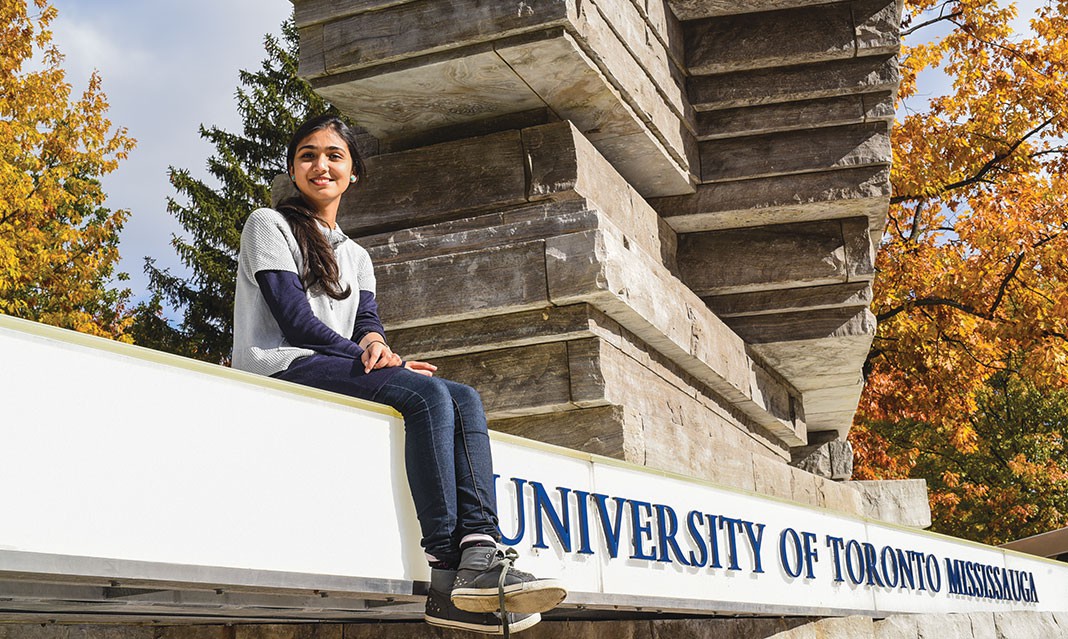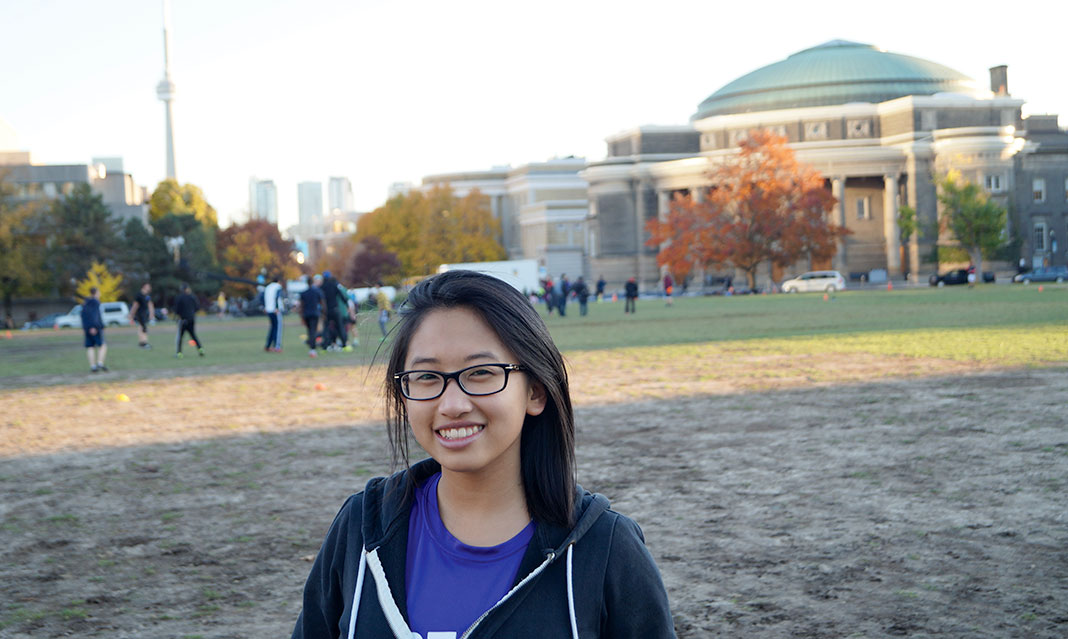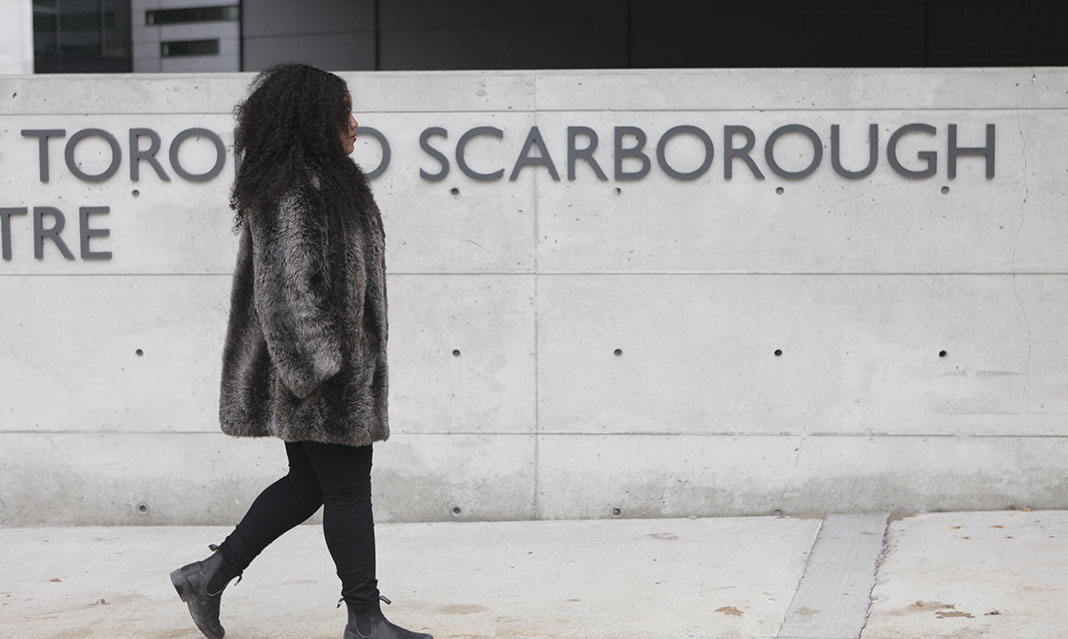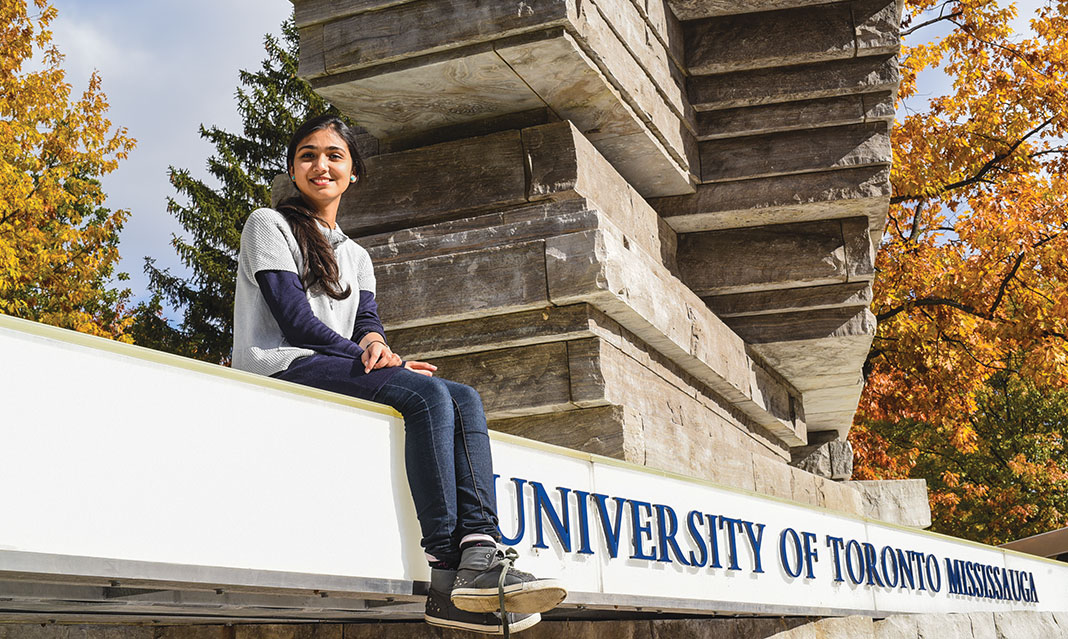This week, The Medium, The Varsity, and The Underground have collaborated to carry out a “U of T student exchange” experience. Writers equipped with only an itinerary and a campus map headed to each sister campus and recorded their experiences.
UTSG’s Marian Mendoza headed towards UTM expecting nothing more than a suburb
Pre-conceived UTM ideas
- Small suburban campus—lots of grass
- Modern buildings—glass?
- Everyone knows everyone (small student population)
- Feels like a high school
One hour and 34 minutes—that’s how long it took me to get from the St. George campus to the Mississauga campus via public transit. I was increasingly impatient due to traffic delays and construction, but my frustration disappeared as soon as the bus pulled onto the UTM campus. As a big fan of architecture and landscapes, the first thing I perceived about UTM was the harmonious integration of modern structures and natural settings.
Farah Qaiser, third-year molecular biology specialist and features editor of The Medium, greeted me upon arrival and took me on a brief walk from the bus loop into the Kaneff Centre and through to the Student Centre.
At UTSG, it’s not uncommon to confidently jaywalk across Queen’s Park with 30 other individuals. At UTM, however, there is simply no need to jaywalk at all; the campus is secluded from urban areas and can be reached by way of a single countryside road. Being in a pedestrian-friendly campus, the buildings are all a short walk away from each other across a series of pedestrian-only pathways. The Student Centre, functioning as the “town hall” of UTM, hosts the UTMSU office, the Medium newspaper, the CFRE Radio station, and various other student organizations. Although small, the Student Centre hosts club booths and the Blind Duck Pub and serves as a relaxing space to hang out with friends—like the ground floor of Sid Smith at UTSG. Qaiser was surprised when I informed her that UTSG is only in the process of developing our own Student Commons.
Dropping off my things at The Medium’s office, I headed over to CFRE (Canada’s First Radio Erindale) and had the chance to listen to a live taping of The Coastline, a student-run radio show hosted by DJs Jiten and Dylan. The show aims to share experiences and issues that students have faced from high school personality phases to dealing with workloads. Apart from representing student life at UTM, the radio group’s aim is to showcase a variety of musical genres and to promote student DJs on campus. When I asked the hosts if there is ever a specific topic to their show, the DJs replied that “there are people that have a topic, not us”.
Situated across from the Student Centre is the Blackwood Gallery, an art gallery featuring the works of local, national, and international professional artists. The gallery’s current exhibit, The Pen Moves across the Earth, is a look at humanity’s influence on nature.
Walking back to the Student Centre, I noticed an open storage room, the space for BikeShare, UTM’s bike rental and repair facility. Noting the small size of their facility, the representative at BikeShare said that there is a high demand for their services, and as a space for students to rent and repair bikes, they hope to expand in the future.
The UTM campus is also situated next to forestry and wildlife. A nature trail adorns back campus, and runs alongside the Credit River, where people will often go fishing. The nature trail was notably empty, unfrequented by UTM students but a recommendable place to de-stress and appreciate the quiet of nature.
Accompanied by The Medium’s features editor, I took this as an opportunity to ask about some common myths about UTM. According to Qaiser, the notion that everyone at UTM knows each other is, in fact, true. Apparently, the school is so small that you’ll recognize almost everyone in your year of study. Unlike UTSG, it’s particularly difficult to avoid someone, even if you try; at UTM, you’re bound to run into them.
I visited UTM’s four-floor library to compare it to our own infamous library, Robarts. UTM’s library, much like Robarts, holds a variety of study environments: desks with dividers, group study rooms, and tables with low dividers for when you want to study with friends but, in reality, procrastinate. There’s a “‘Quiet’ Conversation Study Zone” on the third floor, which is actually a space for loud conversations and food, with maybe the occasional studying on the side.
Coming in to UTM, all I really knew was that there were many trees and glass buildings, but the campus proves to hold so much more. The campus design finds success in its balance between nature and modernity and finds positivity in its friendly environment and tight-knit community.
Final thoughts
Despite its size, UTM is far too lively with student involvement to be compared to a high school.
UTSC’s arts and life editor, Sharine Taylor, headed towards UTSG in search for artwork
Pre-conceived UTSG ideas
• Overcrowded campus
• Hart House would be very busy
• Tradition would overtake modern interests
Having visited the UTSG campus prior to this trip, I had anticipated a heavy flow of students rushing to get to class. My visits downtown were always on the weekends and were primarily for much needed quiet study time inside Robarts. This being my first occasion venturing down on a weekday, I took the initiative of getting off at Museum station to avoid the potential clash of bodies at the interchange station that is St. George.
“Don’t judge a book by its cover,” is one of the classic axioms we are first introduced to in childhood. However, “Don’t judge a campus by its architecture,” would have probably been more fitting in this instance.
Thinking I had cleverly avoided the stream of students, I was still skeptical about what the real difference was between departing the subway at Museum or at St. George station. I was surprised, to say the least, that upon coming out I wasn’t bombarded in the same manner one would be while getting in or out of Union station (being trampled on is unfortunately not in this season).
As such, my first misconception of the campus being heavily saturated with students was disproved. This, of course, is most likely attributed to how much physical space the campus occupies, ultimately accommodating the many students who attend.
Walking around Queen’s Park, with the Pontifical Institute of Mediaeval Studies building and Teefy Hall to my left and cars whizzing by to my right, really put into perspective how University of Toronto’s St. George campus perfectly straddles the line of antiquity and modernity. That being said, it was sort of ironic to read both the name and subject of this study in this contemporary urban space.
I walked further around the perimeter of the park and ended up in the heart of UTSG, the front campus at King’s College Circle. From there, I decided to make my way towards a building whose name I’ve seen listed quite often on my tuition incidental fee breakdown, but which I never really had the opportunity to utilize: Hart House.
Instantaneously feeling envious of every single St. George student for having immediate access to this space, I decided to head straight inside and see all the going-ons within. Assuming that it would be overflowing with students, I was initially hesitant to go in, knowing full well I was part walking with purpose and part aimlessly admiring. My second misconception of Hart House being super busy was proved to be not true. Though it wasn’t as packed as I thought, it was still bustling with activity.
What I really wanted to do was see some art installations and knew that the Justina M. Barnicke Gallery was located somewhere close by. Unfortunately, I had arrived just minutes after the doors were closed but decided to remain on my search for artwork.
Here is where my third misconception was dispelled. I was totally convinced that this particular U of T campus would be so rooted in its tradition that it would be void of embracing any millennial interests.
Lining one of the hallways were Instagram-inspired portraits of students who, I believe, were asked if social media can be a catalyst in social change. Their answers were placed as the captions with their photos. I was delighted that students were allowed to express their social views in a manner that creatively translated their URL activity IRL.
A walk further down the stairs allowed me to see the diversity in activity that takes place in Hart House: a darkroom for developing photos, study spaces, social spaces, and an intimately lit eatery called Sammy’s Student Exchange.
I imagine that this is probably a campus favourite because it was crowded with students talking amongst one another and enjoying its super cozy atmosphere.
With my own hunger inspired, I was now on a mission to find something to eat. Standing on the steps of Hart House looking out onto the front campus made for a picturesque view as students played sports and talked academics with Convocation Hall and the changing reds, yellows, and oranges of autumn leaves as their backdrop. My thoughts were interrupted by a gust of wind. I walked through the neighborhoods surrounding the campus to see if I could find any interesting spots.
One of the many rather overwhelming benefits of attending UTSG is probably having access to a virtually unlimited amount of food options. Just west of the campus is Kensington Market, home to a plethora of unique specialty shops, a spectrum of spiritual gurus and eateries featuring cuisines from locales all over the globe. Tucked away in a charcoal building on Augusta Avenue, I found Trinity Common bar.
The dimly lit restaurant is made for the perfect after-lecture dinner spot. I was lured in mainly by the warmth, but also by the aroma that seeped out from the kitchen. There, I had some tasty fried chicken and waffles with collard greens, sweet potatoes, and fresh lemonade on the side.
With my belly full and my heart ever so content, I continued to walk down College until I saw a forest of greenery peeking through a building’s glass window. This building was UTSG’s Terrence Donnelly Centre for Cellular & Biomolecular Research, and the indoor multi-level bamboo garden was spectacular (and totally Instagram #OOTD worthy). This final stop on my outing to UTSG was the perfect way to wrap up the evening as I snapped photos to add to my VSCO Cam collection.
Though the campus is decorated with its beautiful historic buildings, it has definitely kept up with the times and is far from being as traditional as I had initially speculated.
UTM’s Mahnoor Ayub made the two-hour-long commute to the distant UTSC campus
Pre-conceived UTSC ideas
- Impressive architecture
- Small campus
- Several recreational outlets and engaging student life
- Small forested area
I can still hear the last few Rocket bus announcements echoing through my mind. With stark clarity, I recall the last one: “This is an express route; the next stop is UTSC.”
Looking over my transit instructions one more time, I reassured myself that I must be in the right place. There could be no other place where people would be sitting casually at the bus stop, sipping their beverages, and having animated conversations about the neuromuscular physiology and locomotor capabilities of hummingbirds. It reminded me of where I was coming from—UTM.
After asking for directions and probably being mistaken for a first-year student, I made my way towards the Student Centre. I soon discovered that the way to the building was an uphill trek on a concrete path.
At the top, there were interconnected pathways leading to different buildings that all converged on a common walkway. On my right, I could see all the beauty that autumn had to offer, satisfying the expectations I had when observing UTSC’s famous campus plan. While the contrasting views did seem to form the perfect balance, I was drawn towards the energy radiating from the Student Centre.
I walked in, instantly being tempted by the vast variety of food options available. Resisting the urge to fast-forward my schedule to lunch time, I headed up the stairs in the centre of the floor, allowing me a panoramic view of not only the stalls set up for Clubs Week, but also the buildings beyond.
While I expected to be impressed by UTSC’s architecture, I was surprised by what I felt after completing my exploration of the Student Centre—the strong sense of community present here. (Although upon later conversations, I was met with disagreement from current UTSC students about this, making me realize that self-discontent is essentially what makes our campuses similar.)
I then headed to the Bladen Wing, in search of the Doris McCarthy Gallery. Feeling like a professional for not getting lost, I was welcomed by Julia Abraham as she was preparing for the “Complex Social Change” exhibition beginning the next day.
The exhibition uses various art forms ranging from videos and photography to text and installations to encourage conversations about complex issues such as politics and feminism. Abraham was enthusiastic as she informed me about how the exhibition is only a component of a much larger ambition for instigating social change—but it can also start conversation about what people don’t want to talk about and what has to be said. She informed me about the upcoming displays for “the etiquette and anatomy of social change”, and I noted how UTSC’s awareness through the art scene is definitely something to keep up with.
Heading out of the gallery, I walked past corridors filled with students studying on the sides, blissfully unaware of a lost UTM student in their midst. I realized that I was subconsciously searching for a specific place on the campus. I had reverted to the basic instincts of being a U of T student, which gave me the direction that I needed—when in doubt, head to the library.
I sat down on a colorful chair in the open, welcoming common reading room situated in the middle, open to balconies on the upper floors. Although I was drawn towards the “new DVDs” section on the main shelves, the U of T student in me was applauding the corridors upon corridors of silent study spaces and the self-serve course reserves section. Seeing all the numerous spaces filled, however, could only mean one thing: midterms were coming.
Feeling adventurous, I exited through a deserted pathway and found myself facing a daunting concrete tower-like structure.
I hurried around the building looking for the entrance, making my way through the flowery green pathway. Finally, I discovered that I was standing at the entrance of the humanities wing, an architectural masterpiece designed around massive diagonal staircases.
I sat down peacefully with my lunch in front of the floor-to-ceiling windows that overlooked what appeared to be meadows and preserved nature sites, but were in fact the athletic fields. The view was enough to motivate me to make the long walk to the Toronto Pan Am Sports Centre, so I headed outside and trekked down Military Trail.
Swiping my TCard through, I was amazed at the beautiful competition and recreational pools. Not only does the centre boast an enormous climbing wall with large centres for indoor soccer, basketball, and leadership development, but it is also a model for providing accessibility.
Feeling elated after sharing the spaces previously occupied by outstanding international athletes, I decided to make my way back to UTM. As I passed by a number of long line-ups at Tim Hortons on the way back, I felt like I was at my home campus.
Feeling at ease under the common U of T logo, amidst the anxious midterm and hummingbird physiology conversations, there’s only one thing I can think of as I board the Rocket: when am I coming back?
Final thoughts
• Both old and new buildings present
• Buildings are spread out, but well connected
• Not just the athletic centre, but Rex’s Den was also really cool; strong community present
• The campus has plenty to offer to nature lovers






